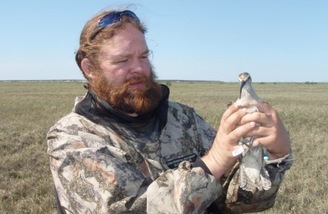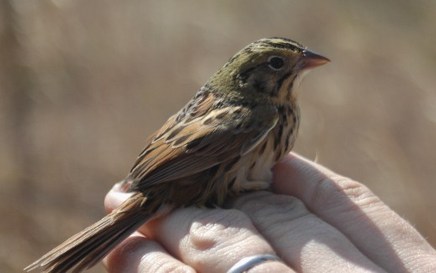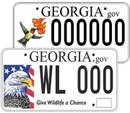Which new wildlife plates? You decide!
 Vote online for next-gen conservation tags
Georgians can vote here on proposed designs for the next generation of wildlife plates. The deadline to vote is Sept. 15. Those votes will help the state Department of Natural Resources choose four new tags – two benefiting the Nongame Wildlife Conservation Fund, and one each for the Bobwhite Quail Initiative and trout management.
The changes, expected by early 2013, take advantage of the state’s switch to what is called a full-plate design. The artwork on current specialty plates covers only a small part of the tag.
Noting the lineup of new designs, DNR Wildlife Resources Division Director Dan Forster said, “We hope that the switch to a full-plate design will excite the public and they will want one on their vehicle.”
Georgia’s wildlife plates provide critical funding for conservation, particularly for nongame wildlife – species not hunted, fished for or trapped – and bobwhite quail, the state game bird.
Since 1997, the nongame plates – currently the bald eagle and ruby-throated hummingbird tags – have supplied 61 percent of Nongame Conservation Fund revenue. Wildlife Resources’ Nongame Conservation Section depends on the fund to conserve, research and restore rare animals, plants and natural habitats statewide. The agency receives no state appropriations, relying instead on grants, private contributions, special fundraisers and the wildlife plates. Nongame Conservation Section Chief Mike Harris called tags “the ballgame for us – the greatest source of funding for nongame conservation in Georgia.”
The same is true for Wildlife Resources’ Bobwhite Quail Initiative, which is working to stem bobwhite population declines by restoring landscapes of native grasses, forbs and shrubs referred to as early successional habitat. Reggie Thackston, Private Lands Program manager and bobwhite project coordinator, said that, as with nongame, no state appropriations are spent on BQI. “The tag revenue is absolutely critical as it is the primary source for restoring bobwhite habitat, which helps not only bobwhites but numerous other wildlife species that depend on early succession,” Thackston said.
The hope is the new-look designs spur new and continued support for Georgia wildlife.
It begins with your vote.
|
 Tag time
-
The first Georgia wildlife plate, featuring a quail in a longleaf pine forest and benefiting the Nongame Wildlife Conservation Fund, was introduced in 1997. The eagle plate came out in 2003, the hummingbird in 2006, and BQI’s deer/quail plate and the Trout Unlimited tag in 2001 (two of the proposed new designs shown at right).
-
Voting on the new designs requires filling out a short survey.
- For nongame, two new tags will be chosen. While voters can pick only one in the online survey, DNR will choose two from the most popular designs.
-
Once new designs are in place, owners can keep their old wildlife plate or buy a new one. The same purchase and renewal fees apply.
- Learn more about supporting wildlife conservation in Georgia.
|
Rare bats elude nets at Rich Mountain
 Biologists map next move for endangered Indianas
An effort to catch some of the first Indiana bats seen in Georgia since the 1960s came up empty-handed this summer. But researchers aren’t discouraged.
“We knew the probability of catching an Indiana bat with so few available netting nights was unlikely,” said Trina Morris, a biologist with DNR’s Nongame Conservation Section. “Bats are difficult to catch and rare species can be especially hard to detect.”
The endangered species had last been documented in Georgia’s Dade County in 1966.
Biologists conducted three mist-netting sessions at Rich Mountain, hoping to confirm what appeared to be a maternity colony. Though no Indianas were captured, other species were – big brown bats (above), eastern red bats, evening bats, little brown bats and northern long-eared bats.
The sessions provided important information about the area’s bat community, as well as discussion about future work involving Indiana bats.
“We always suspected that we had maternity roosts for Indiana bats in Georgia,” Morris said. “Now that there’s somewhere to start, hopefully the state with help from federal partners and biologists in Alabama – where another colony of Indiana bats was discovered this spring – can gather more information about the habits of this species in the extreme southern edge of its range.”
Indianas could also figure into DNR’s monitoring for white-nose syndrome, or WNS, a disease that has killed millions of bats but has not been documented in this state.
As WNS spreads south, biologists will spend the winter looking for evidence of the disease in Georgia bats. Last winter, it was found in Tennessee and Alabama counties along the Georgia state line.
WNS has greatly affected Indiana bats in the Northeast. One question is how the species’ more southern populations will respond to the disease.
The Indiana bats tracked into Georgia and Alabama emerged from a cave in Tennessee. And it’s possible that hibernacula could be affected by white-nose this season.
|
Noteworthy

Butterfly counts are up at the Power of Flight grassland restoration area on Panola Mountain State Park, near Stockbridge. An Aug. 8 count recorded 60 species, a high number attributed to the site’s restored native grasses and use of controlled burns to maintain the grassland.
Georgia reptile and amphibian totals are also on the rise, due to discoveries and taxonomic changes. According to senior biologist John Jensen of the Nongame Conservation Section, Georgia now has 175 native herp species overall, second only to Texas, and 87 amphibian species, just behind first-place North Carolina.
|
A letter supporting the State & Tribal Wildlife Grants program fielded signatures from more than 425 organizations. The U.S. House Appropriations Committee has voted to slice funding by half in fiscal year 2013 – adding to cuts of 31 percent since 2010 – for State Wildlife Grants, the key federal program helping states conserve at-risk wildlife.
Botanists Lisa Kruse and Tom Patrick of the Nongame Conservation Section will help lead sessions at the Georgia Naturalist Rally Sept. 15 at Stone Mountain Park. The event sponsored by the Stone Mountain Memorial Association features walks and talks with subjects varying from native plants to backpacking.
The Agroforestry & Wildlife Field Day Sept. 20 at the University of Georgia’s Griffin campus also includes speakers from the DNR’s Wildlife Resources Division. Landowners and others can learn how to increase the value and benefits of their land with topics such as prescribed burning, cost-share assistance programs and dealing with invasive wildlife.
The first Invasive Species Citizen Scientist Program in coastal Georgia was jumpstarted by Nongame Conservation Section staff with a recent training session in Brunswick. More training on identifying key invasive plants, collecting data and using reporting tools are scheduled. ( Also see "Network targets alien invaders," April 19.)
Loggerhead sea turtles have topped 2,180 nests this summer in Georgia, easily breaking last year’s 1,992 count, the previous record high since comprehensive monitoring began in 1989. Of the estimated 183,788 eggs laid – a total that includes all sea turtle nests on the coast – more than 76,700 hatchlings emerged.
 On the downside, sea turtle strandings in Georgia reached 164, the most recorded from Jan. 1-Aug. 18 since at least 2007. Three of the eight turtles found dead or injured during the most recent week showed signs of being hit by boats, a leading threat.
Want to see what bird banding is all about? Contact Georgia Important Bird Areas Coordinator Charlie Muise ( email) for banding dates at Panola Mountain State Park in Rockdale County and Joe Kurz Wildlife Management Area in Meriwether County, plus a few days at Jekyll Island.
Upcoming:
-
Aug. 29: 9 a.m., Georgia Board of Natural Resources, DNR offices, Atlanta. Agenda.
- Sept. 15: Georgia Naturalist Rally, Stone Mountain Park.
-
Sept. 20: Agroforestry & Wildlife Field Day, UGA Griffin Campus.
- Sept. 21: Outdoor Learning Symposium, Environmental Education Alliance of Georgia, Gwinnett Environmental and Heritage Center, Buford.
-
Sept. 26: 9 a.m., Georgia Board of Natural Resources , DNR offices, Atlanta.
- Oct. 4-6: Gopher Tortoise Council annual meeting, Kirbo Center at Bainbridge College, Bainbridge.
-
Nov. 8: Georgia Exotic Pest Plant Council annual meeting and conference, Stuckey Conference Center, UGA Griffin Campus.
|
Headlines
Rare species profile: Henslow's sparrow
 These secretive, ground-hugging sparrows winter in the Gulf and Southeast
Atlantic coastal plains, from North Carolina to Texas and in parts of the lower
Mississippi River valley. Henslow's favor winter habitats such as grassy areas
in open pine flatwoods, pitcherplant bogs and power-line right of ways. Habitat
loss is a major threat to this species, listed as rare in Georgia. In the Southeast,
only about 10 percent of the open pine forests, savannas and other native grass-
lands favored as winter habitat remain. Henslow's have been documented in
Georgia at Paulk's Pasture Wildlife Management Area near Brunswick, Mayhaw
Wildlife Management Area near Colquitt and Birdsong Nature Center in Thomasville.
Nongame Conservation Section biologists are surveying each winter for the small
birds, shedding light on the distribution and populations of Henslow's (also see
Credits
** Eagle wildlife plate in masthead. Rick Lavender/Ga. DNR
** Collage of proposed wildlife plate designs. Rick Lavender/Ga. DNR
** Big brown bat. Susan Caster
** Fletcher Smith of the Center for Conservation Biology with Akpik, the whimbrel, in the Canadian Arctic. Center for Conservation Biology, College of William & Mary/Virginia Commonwealth University Center
** Patricia Deveau with sea oats planted by TERN and others at Jekyll's Great Dunes Park. Special to DNR
** Henslow's sparrow. Evan Schneider

Give wildlife a chance!
The Nongame
Conservation Section of Georgia DNR receives no state funds to
conserve nongame wildlife, native plants and natural habitats. Instead, we
depend on contributions, grants and fundraisers, such as the eagle and
hummingbird license plates.
How can you help?
Learn more about the Nongame Conservation Section in our
annual
report.
|